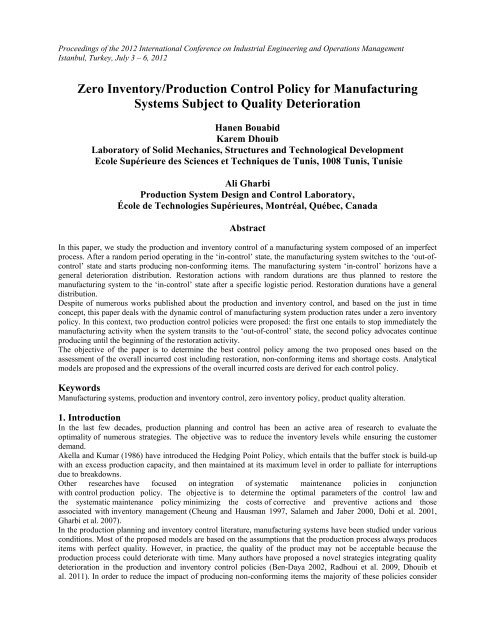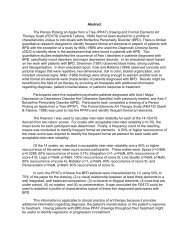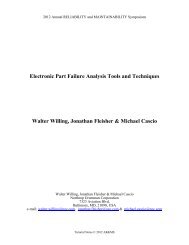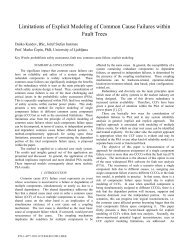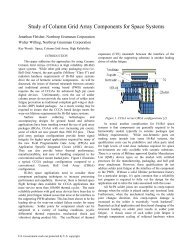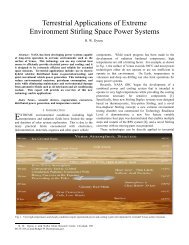Zero Inventory/Production Control Policy for Manufacturing Systems ...
Zero Inventory/Production Control Policy for Manufacturing Systems ...
Zero Inventory/Production Control Policy for Manufacturing Systems ...
Create successful ePaper yourself
Turn your PDF publications into a flip-book with our unique Google optimized e-Paper software.
Proceedings of the 2012 International Conference on Industrial Engineering and Operations ManagementIstanbul, Turkey, July 3 – 6, 2012<strong>Zero</strong> <strong>Inventory</strong>/<strong>Production</strong> <strong>Control</strong> <strong>Policy</strong> <strong>for</strong> <strong>Manufacturing</strong><strong>Systems</strong> Subject to Quality DeteriorationHanen BouabidKarem DhouibLaboratory of Solid Mechanics, Structures and Technological DevelopmentEcole Supérieure des Sciences et Techniques de Tunis, 1008 Tunis, TunisieAli Gharbi<strong>Production</strong> System Design and <strong>Control</strong> Laboratory,École de Technologies Supérieures, Montréal, Québec, CanadaAbstractIn this paper, we study the production and inventory control of a manufacturing system composed of an imperfectprocess. After a random period operating in the ‘in-control’ state, the manufacturing system switches to the ‘out-ofcontrol’state and starts producing non-con<strong>for</strong>ming items. The manufacturing system ‘in-control’ horizons have ageneral deterioration distribution. Restoration actions with random durations are thus planned to restore themanufacturing system to the ‘in-control’ state after a specific logistic period. Restoration durations have a generaldistribution.Despite of numerous works published about the production and inventory control, and based on the just in timeconcept, this paper deals with the dynamic control of manufacturing system production rates under a zero inventorypolicy. In this context, two production control policies were proposed: the first one entails to stop immediately themanufacturing activity when the system transits to the ‘out-of-control’ state, the second policy advocates continueproducing until the beginning of the restoration activity.The objective of the paper is to determine the best control policy among the two proposed ones based on theassessment of the overall incurred cost including restoration, non-con<strong>for</strong>ming items and shortage costs. Analyticalmodels are proposed and the expressions of the overall incurred costs are derived <strong>for</strong> each control policy.Keywords<strong>Manufacturing</strong> systems, production and inventory control, zero inventory policy, product quality alteration.1. IntroductionIn the last few decades, production planning and control has been an active area of research to evaluate theoptimality of numerous strategies. The objective was to reduce the inventory levels while ensuring the customerdemand.Akella and Kumar (1986) have introduced the Hedging Point <strong>Policy</strong>, which entails that the buffer stock is build-upwith an excess production capacity, and then maintained at its maximum level in order to palliate <strong>for</strong> interruptionsdue to breakdowns.Other researches have focused on integration of systematic maintenance policies in conjunctionwith control production policy. The objective is to determine the optimal parameters of the control law andthe systematic maintenance policy minimizing the costs of corrective and preventive actions and thoseassociated with inventory management (Cheung and Hausman 1997, Salameh and Jaber 2000, Dohi et al. 2001,Gharbi et al. 2007).In the production planning and inventory control literature, manufacturing systems have been studied under variousconditions. Most of the proposed models are based on the assumptions that the production process always producesitems with perfect quality. However, in practice, the quality of the product may not be acceptable because theproduction process could deteriorate with time. Many authors have proposed a novel strategies integrating qualitydeterioration in the production and inventory control policies (Ben-Daya 2002, Radhoui et al. 2009, Dhouib etal. 2011). In order to reduce the impact of producing non-con<strong>for</strong>ming items the majority of these policies consider
the construction of a security stock. However, all these researches assume that the inventory level is strictly positiveand do not consider the zero inventory policy advocated by the just in time philosophy.In this paper, and based on the zero inventory strategy, two production control policies were proposed: the first oneentails to stop immediately the manufacturing activity when the system transits to the ‘out-of-control’ state, and thesecond policy advocates continue producing until the beginning of the restoration activity. For the proposed policies,we develop mathematical <strong>for</strong>mulations modeling the overall incurred costs per time unit over an infinite horizon.The overall incurred cost includes shortage, defective items and restoration actions costs.The next section presents the manufacturing system description, notations and assumptions. Section 3 discusses thedynamic and stochastic behavior of the manufacturing system. Mathematical models evaluating the overall incurredcosts per time unit over an infinite horizon are developed in section 4. Section 5 exposes first a numerical exampleand then a sensitivity analysis to show the effectiveness of the proposed methodology. Finally, section 5 contains asummary of the paper and some concluding remarks.2. Description of the production system, notations and assumptions model2.1 Description of the production systemThe system under study is a manufacturing system consisting of a single machine dedicated to producing a singleproduct type to satisfy a constant and a continuous demand. This machine can be considered as an aggregation ofseveral machines. The manufacturing system is subject to random perturbations due to the alteration of productquality during the production phase.At the start, the manufacturing system begins in an ‘in-control’ state producing con<strong>for</strong>ming items of acceptablequality. After a random operating period (τ), the manufacturing process may shift from the ‘in-control’ state to the‘out-of-control’ state and starts producing a percentage (α) of non-con<strong>for</strong>ming items. The manufacturing systemallows instantaneous detection of the ‘out-of-control’ state. The ‘in-control’ state period is a random variable withgeneral probability distribution.A restoration action is started ahead transition to the ‘out-of-control’ state but after a constant delay, denoted logisticdelay period. The logistic delay period is required to prepare all resources necessary <strong>for</strong> restoration actions. Duringrestoration actions, the production process is aborted. The restoration action delay is a random variable having ageneral probability distribution.The manufacturing system operates at a capacity equal to demand d. In order to reduce the impact of product qualitydeterioration and restoration delays on the demand satisfaction, the manufacturing cell can recover the noncon<strong>for</strong>mingitemsby increasing its production rate during the logistic delay period.After a restoration action, the manufacturing facility transits to the ‘as-good-as-new’ ‘in-control’ state and restartsproducing con<strong>for</strong>ming items. Once restorations achieved, the production process is resumed immediately. During arestoration action, an inventory shortage occurs. In this situation, quantities required during a shortage period are notdelivered after the manufacturing system restoration and are considered as lost demand. The objective is to find firstthe expected overall cost incurred per time unit over an infinite spam and then deducing the best policy among theproposed ones.2.2 notationsThe following notations will be used:- d: demand rate.- U max : production capacity of the manufacturing system defining its maximum production rate.- u(t) : controlled production rate of the manufacturing system at time t.- z(t) : production surplus at time t; if z(t) is positive, it represents inventory, while a negative value represents ashortage.-τ: continuous time random variable identifying the distribution of the ‘in-control’ state periods.- f(τ) (F(τ)) : density (distribution) function associated with the random variable τ.- α: percentage of non-con<strong>for</strong>ming items produced during the ‘out-of-control’ period.- LDP: Logistic Delay Period.- t r : continuous time random variable identifying the distribution of the restoration action delays to bring themanufacturing system from the ‘out-of-control’ to the ‘in-control’ state.- h(t r ) (H(t r )) : density (distribution) function associated with the random variable tr.- CT i : total cost incurred by the production-inventory control policy i.- C R : cost of restoration action.
- C S : one-item shortage cost.- C RM : one-item raw material cost.- C MSO : manufacturing system operation cost per time unit.- CF i : expected total cost incurred during production phase of the policy i.- CR i : expected total cost incurred during restoration phase of the policy i.- CS i : expected total cost incurred during shortage phase of the policy i.- LCi: expected value of the production/restoration cycle length <strong>for</strong> policy i.- E(.) : expected value of a random variable.- CNCi : expected cost of non-con<strong>for</strong>ming items manufactured during production phase of the policy i.2.3 AssumptionsOther assumptions are made as follows:• The demands which cannot be satisfied are lost.• The produced items are imperishable with time• The non-con<strong>for</strong>ming items are not reinserted in the production process.• All costs related to restoration activities, quality of manufactured products and inventory management areknown and constant.• The “out of control” state is detected instantly.• The logistic delay period is known and constant.3. <strong>Manufacturing</strong> system production control under zero inventory <strong>Policy</strong>The majority of control policies proposed in the literature are based on the built up of a safety stock with a strictlypositive level (Z max ). The mathematical <strong>for</strong>mulations assessing the overall incurred costs of such strategies do notconsider the case where Z max equals zero. However, and according to the just-in-time philosophy and add-valueproductivity concept, inventories are considered costly categories of waste that should be reduced to the minimum ifnot eliminated (Suzaki 1987, Dear 1988).In this section, we propose a production control policy based on zero inventory concept. The zero inventory policyimplies not to build and not to maintain a security stock during production phases. In effect, and in caseswhere managers adopt zero stock policy, they consent that it is better to suffer the costs of lost demands than costdue to inventory holding. In this case, two different policies can be developed depending on the decision aboutimmediately stopping or not production when the first non-con<strong>for</strong>ming items appeared.3.1 <strong>Policy</strong> 1: description and mathematical <strong>for</strong>mulationThis policy advocates stopping immediately the production if the manufacturing system switches to the “out ofcontrol” state. There<strong>for</strong>e, this policy does not allow the production of any defective item. The transition from the ‘incontrol’state to the ‘out-of-control’ can occur at any instant of the production horizon. Consequently, <strong>for</strong> a constantdemand rate, the related production control policy is given by:()ut⎧dif the manufacturing system is in the 'in-control' state⎪= ⎨ (1)⎪⎩ 0 elsewhereFigure 1 shows, under policy 1, the evolution of the inventory level during the production, the logistic, and therestoration phase.The overall cost is composed of the incurred costs during the production phase and those during the shortage phasewhen the manufacturing system is shut down (Fig. 1). There<strong>for</strong>e, by the renewal theorem, the overall expected cost(CT 1 ) is given by equation (2), where CF 1 equals 0 since no non-con<strong>for</strong>ming items are produced during theproduction phase.CTCF + CSLC1 1= (2)11• Expected cycle length (LC 1 )The expected length of a production/shortage cycle includes the mean lifetime be<strong>for</strong>e transiting to the ‘out-of-
control’ state, the logistic delay period required to prepare the resources <strong>for</strong> the restoration action, and the meanrestoration time.Figure1: <strong>Inventory</strong> evolution during the production/shortage phaseunder control policy 1Hence, the expected production/shortage cycle length is given by equation (3), where E(τ) is the mean life time ofthe manufacturing system ‘in control’ state (Eq. 4), and E(t r ) is the mean duration of restoration actions (Eq. 5).1( τ )LC = E + LDP + μ(3)∫ 0∞( τ ) τ ( τ)E = ⋅ f ⋅dτ∫∞( ) ( )E t = t ⋅h t ⋅dtr r r0r(4)(5)• Expected cost incurred during shortage phase (CS 1 )The expected cost incurred during restoration phase is given by equation (6).( ( ))CS = C + C ⋅d ⋅ LDP + E t(6)1 R S r• Expected overall incurred cost (CT 1 )There<strong>for</strong>e, the expected overall incurred cost under the policy 1 is:CT1C + C ⋅d⋅ R S ( LDP+E( tr))= (7)LC3.2 <strong>Policy</strong> 2: description and mathematical <strong>for</strong>mulationContrary to the policy 1, which stops immediately the manufacturing process when the production system transits tothe “out of control” state, policy 2 permits the production during the logistic delay period. Under this policy, themanufacturing system produced a percentage of non-con<strong>for</strong>ming items equal to α. In order to respond to thedemand, the manufacturing system fills the quantity of non-con<strong>for</strong>ming items by increasing its production rate.Thus the production rate of the manufacturing cell increases from d to d ⋅ ( 1+ α ) . This policy insures that lessshortage items are recorded compared to those recorder under policy 1. The production control under policy 2 isdictated by equation (8).According to the dynamic and stochastic behavior of the manufacturing system controlled by policy 2, figure 2shows the evolution of the inventory level during the production, the logistic, and the restoration phases while thetime evolving.1
⎧dif the manufacturing system is in the 'in-control' state⎪⎪ut () = ⎨d( 1 + α ) if the manufacturing system is in the 'out-of-control' state⎪⎪⎩0 elsewhere(8)Figure2: <strong>Inventory</strong> evolution during the production/restoration phaseunder control policy 2The expected overall cost is composed of the incurred costs during the production phase and those during therestoration phase (Eq. 9).CT2=CF + CR2 2LC2(9)Comparing figures 1 and 2, one can note that the expected cycle lengths (LC 1 and LC 2 ) under policies 1 and 2 areequals.• Expected cost incurred during production phase (CF 2 )The expected cost incurred during the production phase is equal to the cost of non-con<strong>for</strong>ming items. The cost of anon-con<strong>for</strong>ming items includes the cost of the product raw material and the system operating cost. As soon as itshifts to the ‘out-of-control’ state, the manufacturing system starts and continues to produce non-con<strong>for</strong>ming itemsduring the logistic delay period. Thus, the expected cost of noncon<strong>for</strong>ming items produced by the manufacturingsystem under policy 2 is given by:( )CF = CNC = C ⋅d ⋅+ C ⋅α⋅ LDP(10)2 2 RM MSO• Expected cost incurred during restoration phase (CR 2 )The expected cost incurred during the restoration phase is the sum of a restoration activity cost and those due to nondelivered items during the restoration period (Eq. 11).( )CR = C + C ⋅d ⋅ E t(11)2 R S r• Expected overall incurred cost (CT 2 )There<strong>for</strong>e, the expected overall incurred cost under the policy 2 is:CT( )+ + ⋅ ⋅ (12)2 R S r= CNC C C d E t2LC2
4. Numerical example and sensitivity analysisIn this section, we first present a base case. Thus, we carried out a sensitivity analysis in order to show the impact ofthe input parameters on the determination of the best policy.4.1 Base caseConsider a manufacturing system having an automatic machine, manufacturing a single product type, andresponding to a constant and periodic demand of 20,160 units/month. The manufacturing system is subject to arandom alteration of the product quality. The statistics show that the ‘in-control’ state periods follow a Weibulldistribution with shape and scale parameters 1.5 and 1, respectively; the mean lifetime in the ‘in-control’ state of themanufacturing system is equal to 0.903 month.After a random operating period in the ‘in-control’ state, the manufacturing process may shift to the ‘out-of-control’state and starts producing non-con<strong>for</strong>ming items with a percentage equal to 1% of the actual production rate.Upon transition to the ‘out-of-control’ state, a preparation of the required resources <strong>for</strong> restoration with duration of0.03 month is carried out.Restoration actions have random durations following a Gamma distribution with shape and scale parameters 2 and40, respectively; the mean restoration time to the ‘as-good-as new’ ‘in-control’ state is equal to 0.05 month.The following costs are also chosen considering nevertheless realistic context:- Shortage cost (CS): 300 ($/product unit)- Restoration cost (CR): 10,000 ($/restoration action)- Raw material cost (CRM): 500 ($/product unit)- <strong>Manufacturing</strong> system operating cost (CMSO): 150,000 ($/month)Considering the previous input data, the expected overall costs incurred by policies 1 and 2 are respectively equal to4,202,391.02 $/month and 174,281.16 $/month. There<strong>for</strong>e, the best zero inventory/production control policy entailsto produce at the demand rate (20,160 units/month) while the manufacturing system is in the ‘in-control’ state. Oncethe manufacturing system transits to the ‘out-of-control’ state, it ceases producing immediately and its productionrate falls to zero. According to these settings, the minimal overall expected cost incurred by the optimal policy is174,281.16 $/month.4.2 Sensitivity analysisIn order to analyze the superiority of policy 1 to policy 2, expected overall incurred costs equations (2) and (9) werecompared. The analysis has shown that policy 1 outper<strong>for</strong>ms policy 2 if and only if the following condition isrespected:CSCp α ⋅ ⎛⎜C+RM⎝ dMOS⎞⎟ ⎠(13)Equation (13) shows that the relative superiorly of a specific policy depends on the product unit shortage cost, thepercentage of non con<strong>for</strong>ming items, and the cost of producing a non-con<strong>for</strong>ming unit which depends on the rawmaterial cost, the manufacturing process operating cost, and the customer demand.Considering the input parameter of the base case presented previously, equation (3) allows the assessment of thelimiting value of the unit shortage cost implying no superiority of the considered production control policies. Thislimiting condition is obtained when C s equals 5.0149 $/product unit.Table 1 presents 7 configurations of cost parameters derived from the previous configuration (case 1), by changingthem to higher and lower values, one at a time; the case 1 is the manufacturing system configuration considered inthe previous numerical example where C s equals 5.0149 $/product unit. Table 1 highlights the consistency betweenthe variation of each cost parameter and the optimal decision variable and total cost.5. ConclusionsBecause of its great importance <strong>for</strong> manufacturing companies, several researches have been devoted to the problemof modeling and optimizing the production planning and control of stochastic manufacturing systems. Theproduction control policy is generally based on building-up a security stock to palliate against random perturbationsas manufacturing process failures and/or quality product degradation. However, the majority of these controlpolicies and specifically the proposed mathematical models assume that safety stock level equals a strictly positive
value. In today’s industry environment, a huge ef<strong>for</strong>t is deployed in order to reduce to the minimum if not toeliminate inventory which are the principal source of manufacturing waste.CaseNumberCSCRM1 5,0149 500 30,0002 2 500 30,0003 10 500 30,0004 5,0149 200 30,0005 5,0149 2000 30,0006 5,0149 500 10,0007 5,0149 500 80,000Table 1: Sensitivity analysis <strong>for</strong> cost parametersC Eq .14CT CTMCO12CCCCCCCSBest<strong>Policy</strong>CMOS= α ⋅ ⎛ ⎜C+⎞RM⎝ d⎟ 73,578.42 73,578.42 1 or 2⎠CMOSp ⋅ C +SRM ⎟ 31,380.09 72,542.19 1α ⎛⎜⎝Cd⎞⎠MOSf ⋅ C +SRM ⎟ 143,353.54 75,280.25 2α ⎛⎜⎝Cd⎞⎠MOSf ⋅ C +SRM ⎟ 73,578.68 32,612.58 2α ⎛⎜⎝Cd⎞⎠MOSp ⋅ C +SRM ⎟ 73,578.68 278,407.89 1α ⎛⎜⎝Cd⎞⎠MOSf ⋅ C +SRM ⎟ 73,578.68 73,442.95 2α ⎛⎜⎝Cd⎞⎠MOSp ⋅ C +SRM ⎟ 73,578.68 73,917.09 1α ⎛⎜⎝In the other, and contrary to what happens in real industrial context, most of the researches in the productionplanning and control field do not consider explicitly the impact of defective products and the process qualitydeterioration on the determination of the best production control policy of manufacturing systems.This paper presents a production control policy of a manufacturing system including an imperfect process subject toa mono-product, constant, and continuous demand. The production control policy is based on the zero inventorystrategy which entails to not building a finished product security stock during production phase. Based on the zeroinventory strategy, two production control policies were proposed depending on the decision aboutimmediately stopping or not the manufacturing process when the production system switches to the ‘out-of-control’state and starts producing non-con<strong>for</strong>ming items.Analytical models have been proposed <strong>for</strong> manufacturing systems having general distributions of the residencetimes in the ‘in-control’ state and of the restoration periods. The analytical models allow assessing the expectedoverall costs incurred by each production control policy and which includes shortage, restoration, and noncon<strong>for</strong>mingitems costs. The analytical models allow determining the best zero inventory/production control policyto implement based on minimum expected overall cost.The analysis of the analytical models shows that policy 1, which entails stopping immediately the production whenthe manufacturing system transits to the ‘out-of-control’ process, outper<strong>for</strong>ms policy 2, which entails to continueproducing during the logistic delay period, if the product unit shortage cost is less than a specific limit depending onthe percentage of producing non-con<strong>for</strong>ming units and the cost incurred by producing one non-con<strong>for</strong>ming unit.The results reported in this paper extend the theory of the production control policy of manufacturing systemsincluding imperfect processes and subject to product quality deterioration. The proposed approach could beextended to take into account not only product quality deterioration but also equipment failures which <strong>for</strong>ces themanufacturing process to be shut down. In this context, preventive maintenance policies could also be considered inorder to attenuate the impact of catastrophic failures and the shift rate to the ‘out-of-control’ state on the overallper<strong>for</strong>mance of manufacturing systems.d⎞⎠
6. ReferencesAkella, R., Kumar, P. R., Optimal control of production rate in a failure prone manufacturing system,IEEE Transactions on automatic control, vol. AC-31, pp. 116-126, 1986.Ben Daya, M., The economic production lot-sizing problem with imperfect production processes and imperfectmaintenance, International Journal <strong>Production</strong> Economics, vol. 76, pp. 257-264, 2002.Cheung, K.L., Hausman, W.H., Joint determination of preventive maintenance and safety stocks in an unreliableproduction environment, Naval Research Logistics, vol. 44, 1997, pp.257–272, 1997.Dear, A., Working Towards Just-In-Time, Kogan Page, London, 1988.Dhouib., K., Gharbi, A., Ben Aziza, M.N., Joint Optimal <strong>Production</strong> <strong>Control</strong>/Preventive Maintenance <strong>Policy</strong> <strong>for</strong>Imperfect Process <strong>Manufacturing</strong> Cell, International Journal of <strong>Production</strong> Economics, Submitted, 2011.Dohi, T., Okamura, H., Osaki, S., Optimal control of preventive maintenance schedule and safety stocks in anunreliable manufacturing environment, International Journal of <strong>Production</strong> Economics, vol. 74, pp. 147-155,2001.Gharbi, A., Kenné, J.P., Beit, M., Optimal safety stocks and preventive maintenance periods in unreliablemanufacturing systems, International Journal <strong>Production</strong> Economics, Vol. 107, pp. 422-434, 2007.Radhoui, M., Rezg, N., Chelbi, A., Integrated model of preventive maintenance, quality control and buffer sizing<strong>for</strong> unreliable and imperfect production systems, International Journal of <strong>Production</strong> Research, vol. 47,pp. 389-402, 2009.Salameh, M.K., Jaber, M.Y., Economic production quality model <strong>for</strong> items with imperfect quality, InternationalJournal of <strong>Production</strong> Economics, vol.64, pp. 59-64, 2000.Suzaki, K., The New <strong>Manufacturing</strong> Challenge: Techniques <strong>for</strong> Continuous Improvement, Free Press, NewYork, 1987.


